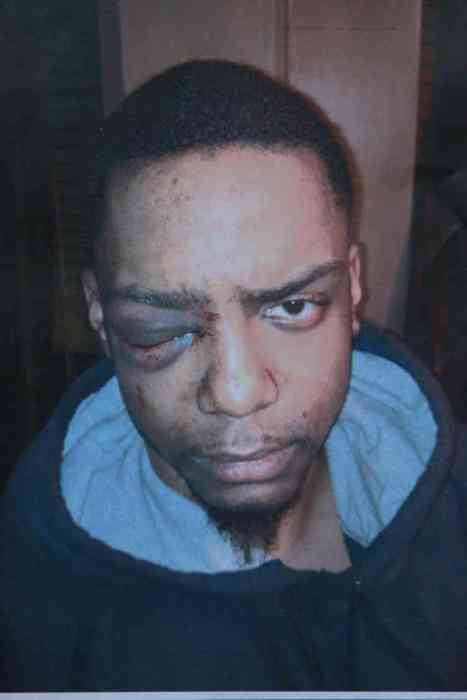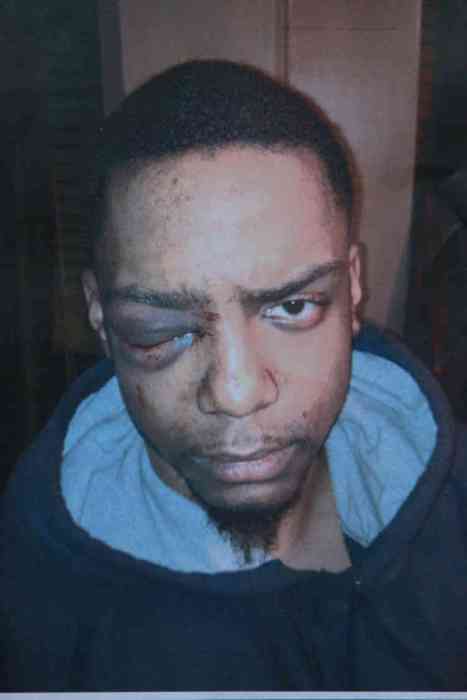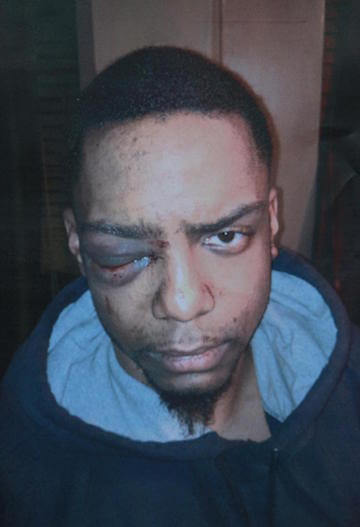Mayer Herskovic being escorted from a courtroom in State Supreme Court in Brooklyn after being found guilty on September 23. | JB NICHOLAS
The sentencing of a Brooklyn man who was convicted last year in a brutal 2013 attack in Williamsburg that left a gay black man blind in one eye was postponed a second time after his attorney said his client was suffering from a medical condition that required surgery.
“He has a serious medical issue that requires medical attention,” said Stuart Slotnick, the attorney for Mayer Herskovic, 24, following the January 18 proceeding. “We’re thankful that Judge Chun is allowing him to seek medical attention.”
On September 23, Danny Chun, the judge who heard the non-jury trial, convicted Herskovic on second-degree assault, first-degree unlawful imprisonment, and menacing charges in the December 1, 2013 attack on Taj Patterson, now 26. Herskovic’s attorney at trial was Israel Fried.
Mayer Herskovic, convicted in brutal Williamsburg beating of gay black man, requires surgery
Sentencing was first scheduled for November 14, but Slotnick made his first appearance on that date and asked for sentencing to be adjourned until January 18 so he could file a motion to vacate the verdict. That motion was never submitted, and it was unlikely to succeed because it would ask Chun to set aside the verdict he had just delivered.
On January 18, Slotnick told the court that his client had developed the medical condition in December and was scheduled for surgery on February 8. He has a second illness that may require a second surgery, though details of his condition were not detailed in open court.
After the conviction, Tim Gough, the assistant district attorney in the Brooklyn prosecutor’s office who handled the case, asked that Herskovic’s bail be revoked and that he be jailed pending sentencing. Chun increased the bail amount, but declined to revoke bail. At the January 18 proceeding, Gough did not oppose Herskovic’s effort to stay out of prison due to medical reasons.
“Based upon the documents provided by Mr. Slotnick, the people have no objection at this time,” Gough said. “The people’s lack of opposition is not going to go on forever.”
With the failure to file the motion to vacate, it appears that Herskovic does not have any legal avenues that will allow him to avoid sentencing. On January 18, Chun told Slotnick that he would not now accept a motion to vacate. Herskovic can appeal once a sentence is imposed, and Chun could allow him to stay out of prison until an appeal is decided.
Sentencing is scheduled for March 16. Herskovic faces a minimum sentence of three-and-a-half years and up to 15 years in prison when sentenced.
Herskovic was among a group of 20 men, some of whom belonged to a neighborhood patrol organized by the Satmar community, who pursued Patterson on Flushing Avenue in the early morning attack.
Videos played during the trial show men chasing Patterson on foot with others in cars racing along the avenue, with some cars pulling into the lane for oncoming traffic on the two-lane avenue.
Taj Patterson, after suffering an assault by a gang of men in Williamsburg in December 2013.
Once caught, Patterson was punched, kicked, knocked to the ground, and had a thumb jammed in his eye. No witness identified Herskovic, but his DNA was found on Patterson’s sneaker, which police recovered from the roof of a low building next to where the young man was assaulted.
Patterson testified that the man who punched him in the face, jabbed a thumb in his eye, and kicked him in the face as he lay on the ground was the same man who pulled off his sneaker and tossed it onto the building.
At trial, Fried attacked the DNA evidence, including bringing in his own expert witness, but Chun was clearly knowledgeable about DNA evidence and was not swayed by the defense.
The DNA was found using high sensitivity DNA testing, a process that is used by the city’s medical examiner’s office. While many labs across the country use high sensitivity DNA testing, the city’s medical examiner’s is the only US lab that uses such testing to develop evidence in criminal trials.
High sensitivity DNA testing uses samples that are measured in picograms, or trillionths of a gram. These samples could include as few as five or six skin cells. The medical examiner’s office analyzes the test results with proprietary software called the Forensic Statistical Tool, which produces a ratio indicating how likely it is that a particular individual contributed to a DNA sample.
Before Herskovic’s trial began, Pinchas Braver and Abraham Winkler pleaded guilty to unlawful imprisonment in the attack. Charges against Aharon Hollender and Joseph Fried were dropped.

























